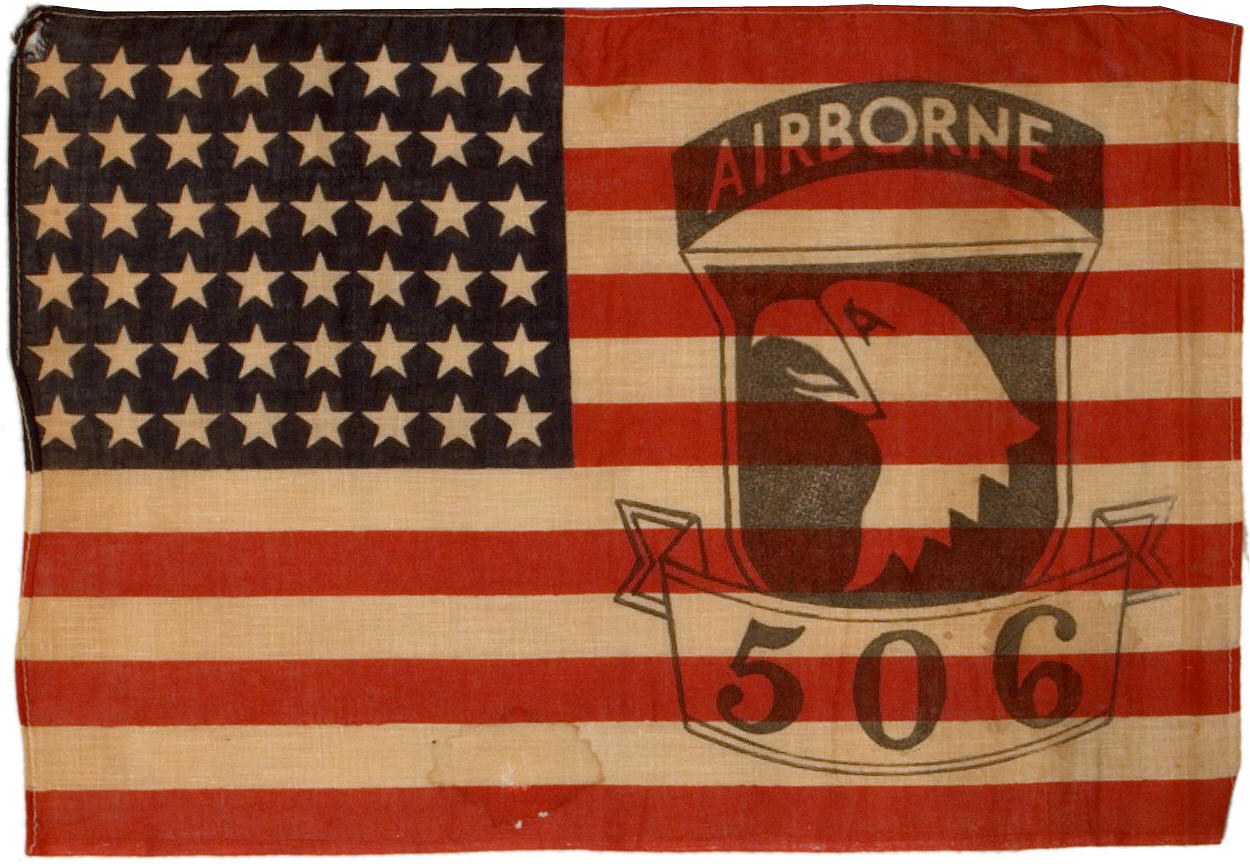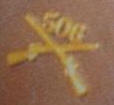|

Over several years of collecting, I've encountered a
small handful of similarly constructed 48 star flags
which feature black overprinted designs on the stripes
to the right of the canton. They are very scarce.
One such flag in the Rare Flags collection features an
advertisement for a fishing reel. Another I've
seen features a baseball advertisement, and another
another an ad for Winchester rifles. Of all of the
48 star flags that I've seen, none has ever featured an
overprint of a World War II military unit. That
degree of rarity in itself makes this flag
extraordinary. With that in mind, the particular
unit featured on this flag makes this flag nothing short
of astonishing. The unit commemorated on this flag
is the 506th Parachute Infantry Regiment of the famed
101st Airborne Infantry Division. The Regiment,
commanded by Col. Robert F. Sink, is best known for the
portrayal of its E Company, 2nd Battalion, 506th
Parachute Infantry Regiment, in the book "Band of
Brothers" written by historian Stephen E. Ambrose and
subsequently made into a modern classic television
series of the same name by producers Stephen Spielberg
and Tom Hanks.
 The
Regiment, known as the Currahees, formed at Camp Toccoa,
Georgia in 1942. The Regiment's first action of
the war was Operation Chicago, a component of Operation
Overlord whereby gliders dropped elements of the 101st
Airborne Division, including the 506th, behind enemy
lines in the pre-dawn hours of D-Day, June 6, 1944.
Their most famous action during Operation Overlord was
the assault by E Company on Brécourt Manor, led by 1LT
Richard Winters. In September, 1944, the unit
participated in Operation Market Garden, which, at the
time, was the largest airborne operation ever launched.
After a brief period of recovery in Paris, the unit next
participated in the Battle of the Bulge, being encircled
by enemy forces at Bastogne along with the whole of the
101st Airborne Division. Besieged, isolated and
undersupplied during the coldest months of the winter,
from December 1944 to January 1945, the 506th was
assigned to hold the eastern sector of the Division
line. One third of 1st Battalion--nearly 200
men--were killed fighting delaying actions against the
German advance. Replaced on the line by 2nd and
3rd Battalion, the 506th held the line until the U.S.
Third Army, led by General George Patton, broke the
101st out of Bastogne in February, 1944. With the
majority of its heavy fighting behind it, the 506th was
reintroduced to the front lines in April, 1944, and
participated in the push across Europe into Germany and
the subsequent occupation of Austria. Although the
Regiment prepared for deployment to the Pacific theater,
the war ended in 1945 before they redeployed and the
unit was deactivated in 1945. Although the unit
was later reactivated after the war as the 506th
Airborne Infantry Regiment in 1948-1949, again from
1950-1953, and finally in 1954, these later troops did
not receive airborne training, nor were they authorized
to wear the airborne patch above the 101st Infantry
Division Screaming Eagle patch.1 The
Regiment, known as the Currahees, formed at Camp Toccoa,
Georgia in 1942. The Regiment's first action of
the war was Operation Chicago, a component of Operation
Overlord whereby gliders dropped elements of the 101st
Airborne Division, including the 506th, behind enemy
lines in the pre-dawn hours of D-Day, June 6, 1944.
Their most famous action during Operation Overlord was
the assault by E Company on Brécourt Manor, led by 1LT
Richard Winters. In September, 1944, the unit
participated in Operation Market Garden, which, at the
time, was the largest airborne operation ever launched.
After a brief period of recovery in Paris, the unit next
participated in the Battle of the Bulge, being encircled
by enemy forces at Bastogne along with the whole of the
101st Airborne Division. Besieged, isolated and
undersupplied during the coldest months of the winter,
from December 1944 to January 1945, the 506th was
assigned to hold the eastern sector of the Division
line. One third of 1st Battalion--nearly 200
men--were killed fighting delaying actions against the
German advance. Replaced on the line by 2nd and
3rd Battalion, the 506th held the line until the U.S.
Third Army, led by General George Patton, broke the
101st out of Bastogne in February, 1944. With the
majority of its heavy fighting behind it, the 506th was
reintroduced to the front lines in April, 1944, and
participated in the push across Europe into Germany and
the subsequent occupation of Austria. Although the
Regiment prepared for deployment to the Pacific theater,
the war ended in 1945 before they redeployed and the
unit was deactivated in 1945. Although the unit
was later reactivated after the war as the 506th
Airborne Infantry Regiment in 1948-1949, again from
1950-1953, and finally in 1954, these later troops did
not receive airborne training, nor were they authorized
to wear the airborne patch above the 101st Infantry
Division Screaming Eagle patch.1
 This
flag surfaced in a grouping of items, including an Army
Class-A dress
uniform, in the estate of a 2nd
Lieutenant of the 506th Regiment found in the mid 1990's in Bergen County,
New Jersey. Although the specific company
and name of the lieutenant who owned the flag is
unknown, the flag was special enough for him to frame it
and keep it among his personal effects for the remainder
of his life. The uniform is World War II vintage, and
the presence of the 506th Infantry Regiment unit
designation pin (pictured left) and airborne wings on the uniform, as
well as the Airborne patch above the Division patch seen
on the flag's overprint, are clear evidence that
the flag is associated with the World War II unit, and
not a later period reorganization of the unit.
Whether this flag was made and distributed to soldiers
during their formation and war years (1942-1945), during
their homecoming in 1945, or as a post-war reunion
commemorative is not known. The flag's 48 stars
indicates that it was made some time between the unit's
formation in 1942 and the introduction of Alaska to the
Union in January, 1959. This
flag surfaced in a grouping of items, including an Army
Class-A dress
uniform, in the estate of a 2nd
Lieutenant of the 506th Regiment found in the mid 1990's in Bergen County,
New Jersey. Although the specific company
and name of the lieutenant who owned the flag is
unknown, the flag was special enough for him to frame it
and keep it among his personal effects for the remainder
of his life. The uniform is World War II vintage, and
the presence of the 506th Infantry Regiment unit
designation pin (pictured left) and airborne wings on the uniform, as
well as the Airborne patch above the Division patch seen
on the flag's overprint, are clear evidence that
the flag is associated with the World War II unit, and
not a later period reorganization of the unit.
Whether this flag was made and distributed to soldiers
during their formation and war years (1942-1945), during
their homecoming in 1945, or as a post-war reunion
commemorative is not known. The flag's 48 stars
indicates that it was made some time between the unit's
formation in 1942 and the introduction of Alaska to the
Union in January, 1959.
1 Summarized history
from Wikipedia, http://en.wikipedia.org/wiki/506th_Infantry_Regiment.
|

